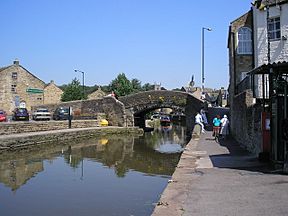Thanet Canal facts for kids
Quick facts for kids Thanet Canal (Springs Branch) |
|
|---|---|

The Springs Branch leading off northwards from its junction with the Leeds and Liverpool canal
|
|
| Specifications | |
| Locks | 0 |
| Status | navigable |
| History | |
| Original owner | Lord Thanet |
| Date of act | 1773 |
| Geography | |
| Start point | Skipton Castle loading dock |
| End point | Skipton |
| Connects to | Leeds and Liverpool Canal |
The Thanet Canal, also called the Springs Branch, is a small waterway connected to the Leeds and Liverpool Canal. It starts in Skipton and goes to loading areas near Skipton Castle. These areas were used to load limestone from nearby quarries onto boats. The canal opened in 1773 and was made longer in 1794.
Contents
Building the Canal
In the late 1700s, Lord Thanet owned Skipton Castle. He also owned limestone quarries close to the castle. When the Leeds and Liverpool Canal was being built, he asked the builders to change its path. He wanted the canal to go closer to his quarries.
Why a New Canal?
The canal builders said no to Lord Thanet's request. So, on May 10, 1773, he got a special law passed by Parliament. This law, called an Act of Parliament, allowed him to build his own branch canal. Lord Thanet paid for the canal himself. He did not need to raise money from others. Most of the canal was built on his own land. The canal's other name, Springs Branch, comes from the original law. That law was for a "Canal from a Place called the Spring, lying near Skipton Castle."
Quick Construction
The Thanet Canal was built very quickly. It was only about one-third of a mile (0.5 km) long. It started from the Leeds and Liverpool Canal in the middle of Skipton. Then, it went around the back of Skipton Castle. Here, there were special loading chutes. Limestone from the quarries was tipped into these chutes and loaded onto boats.
Canal Changes Over Time
In 1785, the company that owned the Leeds and Liverpool Canal took over the Thanet Canal. In 1794, the canal was made even longer. Workers added a 240-yard (220-meter) extension. This new part led to a new loading dock. A special track, called a tramway, connected this dock to the quarries.
Much of the limestone went to the Low Moor Ironworks in Bradford. There, it was used to help make iron. Limestone was also used to build roads. Some of it was burned to make lime. This lime was used as fertilizer for farms. It was also used to make mortar for building.
Improving the Loading Process
When the tramway was first built, its end was much higher than the canal. This meant long chutes were used to load the limestone. But this caused problems. The long chutes damaged the boats. Also, the noise from the falling limestone bothered the people living in the castle.
To fix this, a steeper tramway was built. This allowed for shorter chutes. Shorter chutes meant less noise and less damage to the boats. You can still see one of these shorter metal chutes today. It is on the canal bank, below the walls of Skipton Castle.

